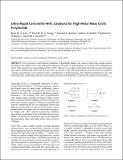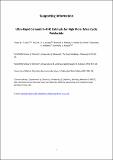Files in this item
Ultrarapid cerium(III)–NHC catalysts for high molar mass cyclic polylactide
Item metadata
| dc.contributor.author | Kerr, Ryan W. F. | |
| dc.contributor.author | Ewing, Paul | |
| dc.contributor.author | Raman, Sumesh K. | |
| dc.contributor.author | Smith, Andrew D. | |
| dc.contributor.author | Williams, Charlotte K. | |
| dc.contributor.author | Arnold, Polly L. | |
| dc.date.accessioned | 2022-01-15T00:42:08Z | |
| dc.date.available | 2022-01-15T00:42:08Z | |
| dc.date.issued | 2021-01-15 | |
| dc.identifier | 272308476 | |
| dc.identifier | 0a85d987-9d2a-44e9-9ee5-fc302ecca4fa | |
| dc.identifier | 85099922967 | |
| dc.identifier | 000618540300044 | |
| dc.identifier.citation | Kerr , R W F , Ewing , P , Raman , S K , Smith , A D , Williams , C K & Arnold , P L 2021 , ' Ultrarapid cerium(III)–NHC catalysts for high molar mass cyclic polylactide ' , ACS Catalysis , vol. 11 , pp. 1563-1569 . https://doi.org/10.1021/acscatal.0c04858 | en |
| dc.identifier.issn | 2155-5435 | |
| dc.identifier.other | ORCID: /0000-0002-2104-7313/work/87403931 | |
| dc.identifier.uri | https://hdl.handle.net/10023/24667 | |
| dc.description | The EPSRC are acknowledged for research funding through the Centre for Doctoral Training in Critical Resource Catalysis (CRITICAT, EP/ L016419/1, R. W. F. K., P. M. D. A. E.), EP/J018139/1, the UK Catalysis Hub (EP/K014714/1, P. L. A., C. K. W., S. K. R.), EP/M010554/1 (P. L. A.) and EP/S018603/1 (C. K. W.). This project has received funding from the European Research Council (ERC) under the European Union’s Horizon 2020 research and innovation programme (grant agreement No 740311, P.L.A.). | en |
| dc.description.abstract | Cyclic polyesters could improve the properties of degradable plastics, but routes to them that provide a product with faster rates, higher molar mass, and greater selectivity for cyclic vs linear polymer are needed. Here, homogeneous Ce(III)–N-heterocyclic carbene (NHC) catalysts show outstanding activities (turn-over-frequency (TOF) > 864 000 h–1), excellent control, and selectivity for cyclic polylactide (PLA) topology (>95%), yielding high molar mass PLA (60 < Mn < 250 kg mol–1). They efficiently produce cyclic PLA from rac-lactide or l-lactide and aliphatic cyclic polyesters from ε-caprolactone or β-butyrolactone. The enhanced performances are only achievable from combining cooperative Lewis acidic cerium(III) and hemilabile N-heterocyclic carbene functionalities. | |
| dc.format.extent | 565903 | |
| dc.format.extent | 2441443 | |
| dc.language.iso | eng | |
| dc.relation.ispartof | ACS Catalysis | en |
| dc.subject | Polymerization | en |
| dc.subject | Catalysis | en |
| dc.subject | Cerium | en |
| dc.subject | Polylactide | en |
| dc.subject | Cyclic | en |
| dc.subject | NHC | en |
| dc.subject | QD Chemistry | en |
| dc.subject | DAS | en |
| dc.subject.lcc | QD | en |
| dc.title | Ultrarapid cerium(III)–NHC catalysts for high molar mass cyclic polylactide | en |
| dc.type | Journal article | en |
| dc.contributor.sponsor | EPSRC | en |
| dc.contributor.sponsor | EPSRC | en |
| dc.contributor.institution | University of St Andrews. School of Chemistry | en |
| dc.identifier.doi | https://doi.org/10.1021/acscatal.0c04858 | |
| dc.description.status | Peer reviewed | en |
| dc.date.embargoedUntil | 2022-01-15 | |
| dc.identifier.grantnumber | EP/L016419/1 | en |
| dc.identifier.grantnumber | EP/J018139/1 | en |
This item appears in the following Collection(s)
Items in the St Andrews Research Repository are protected by copyright, with all rights reserved, unless otherwise indicated.


